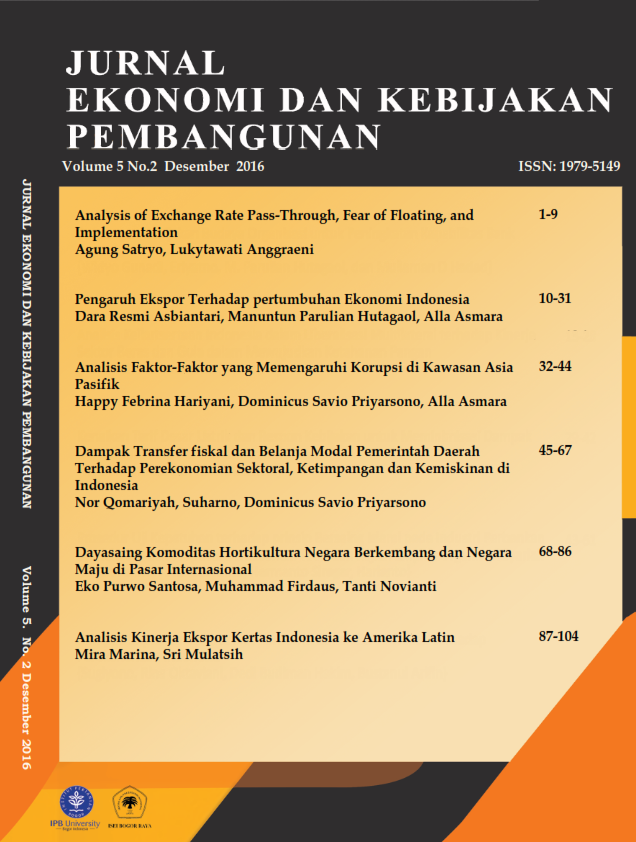ANALISIS FAKTOR-FAKTOR YANG MEMENGARUHI KORUPSI DI KAWASAN ASIA PASIFIK
Abstract
References
Ades A, Di Te. 1995. Competition and Corruption. Draft Paper. Keble College. Oxford University
Aleksandra F. 2000. Stability and Corruption in South Eastern Europe – Corruption is a Way of Life in South-Eastern Europe – a Necessary Method of Survival. South-East Europe Review. 4/2000
Andvig JC, Fjeldtad OH, Amundsen I, Sissener T, Søreide T. 2000. Reasearh on Corruption: A Policy Riented Survey. [NORAD] Norwegian Agency for Development Co-operation.
Blackburn, Keith NB, and M. Emranul H. 2006. Economic Discussion Paper EDP-0530. The University of Manchester.
Chetwynd E, Frances C, Bertram S. 2003. Corruption and Poverty :A Review of Recent Literature (Final Report). Washington DC: Management System International.
Churchill, Ransford Q, Agbodohu W, Arhenful. P. 2013. Determininf Factors Affecting Corruption: A Cross Country Analysis. International ournal of Economics, Business, and Finance, Vol 1, No. 10, November 2013, pp : 275-258.
Damanhuri DS. 2010. Ekonomi Politik dan Pembangunan: Teori, Kritik, dan Solusi bagi Indonesia dan Negara Berkembang. Bogor: IPB Press.
Elliott KA. 1997. Corruption as an International Policy Problem: O verview and Recommendation.
Gillespie K, Gwenn O. 1991. The Political Dimensions of Corruption Cleanups: A Framework for Analysis. Comparative Politics, Vol. 24, No.1.
Huntington SP. 1968. Political Order in Changing Societies. New Haven: Yale University Press
Lui F. 1985. An Equilibrium Queuing Model of Bribery. Journal of Political Economy. August, 93(4): 760-781.
Mo PH. 2000. Corruption and Economic Growth. Journal of Comparative Economics. 29:66- 79.
Nawatmi S. 2014. Korupsi dan Pertumbuhan Ekonomi NegaraNegara Asia Pasifik. Jurnal Bisnis dan Ekonomi (JBE), Maret 2014, Hal 73-82, Vol 21. No.1. Fakultas Ekonomika dan Bisnis, Universitas Stikubank Semarang.
Paldam M. 2002. The Cross-Country Pattern of Corruption: Economics, Culture and the Seesaw Dynamics. European Journal of Political Economy, 18(2):215{240. 22}
Rose-Ackerman, Susan. 1999. Corruption and Government: Causes, Consequences, Reform. The Press of The Univesity of Cambridge.
Tanzi V. 1998. Corruption Around the World: Cauces, Consequences, Scope and Cures. IMF Staff Papers, Vol. 45, No. 4.
Transparency International. 2015. Corruption Perceptions Index Kawasan Asia Pasifik Tahun 2004-2014. [http://www.transparency.org/] diakses pada 20 Februari 2016
Treisman D. 2000. The Causes of Corruption: A Cross-National Study. Journal of Public Economics, 76: 3, pp 399–457.
[UNISDEM] Uni Sosial Demokrat. 2015. Metode Korupsi di Asia Pasifik Semakin Vulgar dan Telanjang. [http://www.unisosdem.org] diakses pada 21 Maret 2016.
World Bank. 1997. Helping Countries Combat Corruption. The Role of the World Bank. Pp-8.
Authors

This work is licensed under a Creative Commons Attribution-NonCommercial-ShareAlike 4.0 International License.
The authors who publis article(s) in Jurnal Ekonomi and Kebijakan Pembangunan have to understand and agree that the copyright of article published is owned by Jurnal ekonomi and Kebijakan pembangunan including to reproduce, distribute and sell this journal to public.





